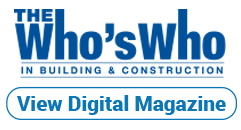 Cover Story
Cover Story
Raising The Concrete Bar
Concrete Lifting Technologies elevates product and possibilities for clients

The Concrete Lifting Technologies team with company mascot Caesar. Pictured, from left: General Manager Kevin Schiltz, Business Development Manager James Weber and Owner David Hare.

A major benefit of polyurethane concrete lifting is the smaller holes required for injection compared to traditional mudjacking. Here, a technician injects polyurethane foam to raise a walkway to eliminate trip hazards.
In Wisconsin, the winters can be brutal, with temperatures dipping at times into minus double digits. That extreme cold takes its toll on concrete structures, causing sinking sidewalks, driveways and patios, and cracking in foundations and concrete floors.
David Hare had that in mind as he visited the World of Concrete trade show in Las Vegas seven years ago and came across a vendor promoting a technology that physically lifts concrete with polyurethane. As the owner of a successful drywall and plastering business in Sun Prairie, a suburb of Madison, David saw an opportunity to bring a new technology for concrete lifting to his home state.
From Stilts to Sinkholes
“In my drywall business, I run around on stilts to reach high walls and ceilings. I won’t always be able to do that,” David says. “When I got home from the trade show, I had to inform my wife that I purchased a new piece of equipment to start up another business. She said, ‘Great. You’re already stressed over the first one.’ I told her, ‘Don’t worry; it will be fine.’ And here we are seven seasons later.”
And fine it is. Concrete Lifting Technologies has seen steady growth as it offers a cost-effective, environment-friendly solution to raise concrete for homes and businesses. Its residential services include polyurethane concrete lifting and support, soil stabilization, sinkhole, void filling, foam injection and much more. The company also fills basement and garage voids to keep homes on solid footing. Commercial services include warehouse floor leveling, slabjacking and foam injection. It also takes on large-scale projects, including highway repairs, bridge approaches and curb raising.
A Superior Alternative
Traditionally, concrete is raised by a process called mudjacking, which pumps a heavier sand-based material infused with Portland cement under a slab to raise concrete. Polyurethane concrete lifting uses a light foam material that expands when injected. While both methods achieve the same result of raising and supporting sunken or unstable concrete, polyurethane offers distinct advantages.
The lighter polyurethane material expands to fill any voids. And the material never loses density. Plus, it sets in a matter of minutes rather than days. Also, it uses smaller holes for injection—5/8-inch holes as compared to 1½-inch to 2-inch holes. (Think dime size as compared to Coke-can size.)
“The foam is made from 40% to 50% recycled material. It’s eco-friendly, nontoxic, waterproof and its shelf life is hundreds of years. It never breaks down or washes away,” David says. “Also, you can drive or walk on it that same day, within 10 minutes of injection.”
Golf Helps Grow Business
Selling customers on the new technology started off slowly. The first year in business was discouraging, and David put the piece of equipment away and went back to what he was good at—plaster repairs. But the next year, after the equipment company sent a representative to consult with him on its use, business started picking up, increasing 15% each year for the next two years.
Sales really took off three years ago after David met Kevin Schiltz, who joined the firm as General Manager. Retired from a 32-year military career, Kevin was looking for something to do. “David and I were in the same golf league and he proposed that I run the company,” Kevin recalls. “We reached an agreement, and today, here we are just killing it,” he says.
Kevin has used his expertise as an engineer for the U.S. Army and most recently the Army Corps of Engineers, where he worked on large construction projects all over the world, to help double business each year since joining the company.
Then Kevin met James Weber—also on the golf course. “I was complaining about the challenge of getting the word out to find the right customers. James was in marketing with a local TV station and shared some of his ideas,” Kevin says.
These ideas included using different avenues to market the business, beginning with a small digital campaign and growing to the use of billboards and 30-second TV spots. When they saw the success of the campaign, David and Kevin brought James on board full time as Business Development Manager last year.
‘It Ain’t Mudjack’
TV advertising using the slogan, “It ain’t mudjack,” has helped spread the word. “It’s a newer technology and people don’t know about the benefits of polyurethane foam. Our commercials help them realize this is a better product,” James says. TV and billboard ads promote the “ItAintMudjack.com” website, which leads visitors to Concrete Lifting Technologies’ website.
Today, the firm’s “bread and butter” market is made up of homeowners looking to lift concrete driveways, sidewalks, pool decks and other sunken concrete. But the company is also building its commercial business, attracting warehouse and factory clients that have large concrete floors prone to curling or cracking. Concrete Lifting Technologies also performs commercial lifting on highways and bridge approaches.
The team shares many examples of how it has saved customers time and money by lifting concrete using polyurethane technology instead of replacing it.
One example takes us on a walk around Lake Mendota. Years of erosion caused instability and unevenness along the lake’s retaining wall and walking path. Concrete Lifting Technologies used its deep foam-injection process to stabilize the soil, which then supported the sidewalk and prevented further erosion. The job was completed in one day at one-fifth the price, compared to the two weeks of inconvenience and added expense that a total replacement would have cost.
Another prime example is the Harbor Athletic Club in Middleton, Wisconsin. The management team was facing a $77,000 expense to replace pool decks and patios and $125,000 to correct concrete instability inside the facility. Numerous trip hazards, cracks and voids were caused by years of erosion beneath the building and instability inside the facility’s 88-foot-long corridor. Concrete Lifting Technologies came in to work in the early morning hours during the club’s peak season to correct the pool deck issues. Crews then filled the area below the corridor and internal area, stabilizing the soil while lifting the floor to strengthen the bond between the wall bases and floor. The repairs were made for a total of $21,000 and all in a day’s time.
David recalls a request from a hospital to level an area for oxygen tank storage. Two mudjacking firms said the job was out of their league. Concrete Lifting Technologies took on the challenge, raising 885,000 pounds up 2¾ inches. “We saved the hospital a ton of money, probably upward of $150,000,” David says. “They would have had to set up temporary oxygen tanks somewhere, remove existing tanks, tear out and re-pour the whole slab, then move the tanks back.”
Concrete Lifting Technologies also saved a nearby city considerable time and expense to repair manholes over storm sewers that were breaking apart. “It would have cost the city around $2,000 apiece to replace the manholes,” Kevin says. “The city pulled the manhole and storm sewer grates off and we foamed and stabilized them for around $200 apiece, saving the city hundreds of thousands of dollars.” In another municipality job, the firm lifted a bridge approach, raising an 18-inch concrete slab 3 inches. “We did the job in a matter of hours to get the road back open quickly,” Kevin adds.
With thousands of examples of raising sidewalks and patios for homeowners, one residential job in particular stands out. “We were called to help a homeowner raise the slab of his home that was built on a hill,” Kevin recalls. “In the home’s living room, the slab had sunk 4 to 5 inches. We injected foam and lifted the floor level and saved his home from sliding down the hill.”
“The foam is made from 40% to 50% recycled material. It’s eco-friendly, nontoxic, waterproof and its shelf life is hundreds of years. It never breaks down or washes away. Also, you can drive or walk on it that same day, within 10 minutes of injection.” David Hare, Owner, Concrete Lifting Technologies
Growing Into New Markets
Concrete Lifting Technologies is opening up a new location this spring in Osseo to service northwestern Wisconsin, including the cities of Eau Claire, La Crosse, Black River Falls and others northward. “Although we serve south-central and northwestern Wisconsin, we basically go where the jobs are,” Kevin says.
David, Kevin and James are located at the main office in Sun Prairie, where they are among eight employees, including Kevin’s two sons, one a former Marine, along with one of his son’s best friend. “We’re very family-oriented and a close-knit group,” Kevin says. “We know each other’s family members—wives, girlfriends and kids. Even my dog, Caesar, is the company mascot. Our ethics are steeped in military values—honor, integrity, respect, sacrifice. If you build your company ethos on that, you will be all right.”
The company believes in giving back to the community, and has done a number of projects for its hometown, including a job at Angell Park Speedway, a dirt track for midget and sprint car events that is owned and operated by the Sun Prairie fire department. The firm has also completed work for a historical museum in the nearby Village of Pardeeville, where it filled a large underground void to keep the building’s foundation from further settling.
Concrete Lifting Technologies also sponsors the radio and TV broadcasts of local football games and the Lou Bradley Memorial Pro-Am tournament that draws some of the world’s best racquetball players to the Prairie Athletic Club, where David, Kevin and James met through their love of golf. The tournament, an International Racquetball Tour event, is in its 23rd year.
During the winter months, cold weather freezes the ground and prohibits concrete lifting work. The team spends the four-month downtime on marketing to book business for the following spring. “I just did 20 quotes today and another 20 the day before,” James says during a January interview. “We’re getting set up for jobs in April, May and June so we can hit the ground running.”
Ultimately, the company goal is to attract more inside work at factories and warehouses in order to keep a crew going year-round.
“We want to continue our slow, steady growth and keep branching out to different markets, perhaps into other states,” David says. “We’re also looking at franchise opportunities, possibly bringing a few partners on board to help them be successful.”
Last year, Concrete Lifting Technologies earned the Platinum Level designation from HMI, a company that sells polyurethane foam. It’s the highest level of four in HMI’s Elite Program, which recognizes the amount of product a company purchases.
“It’s a good gauge to see how you’re growing,” David notes. “When Kevin joined the company, we were at the Silver Level.”
“We plan on being Platinum forever,” Kevin adds.

 Login / Register
Login / Register



